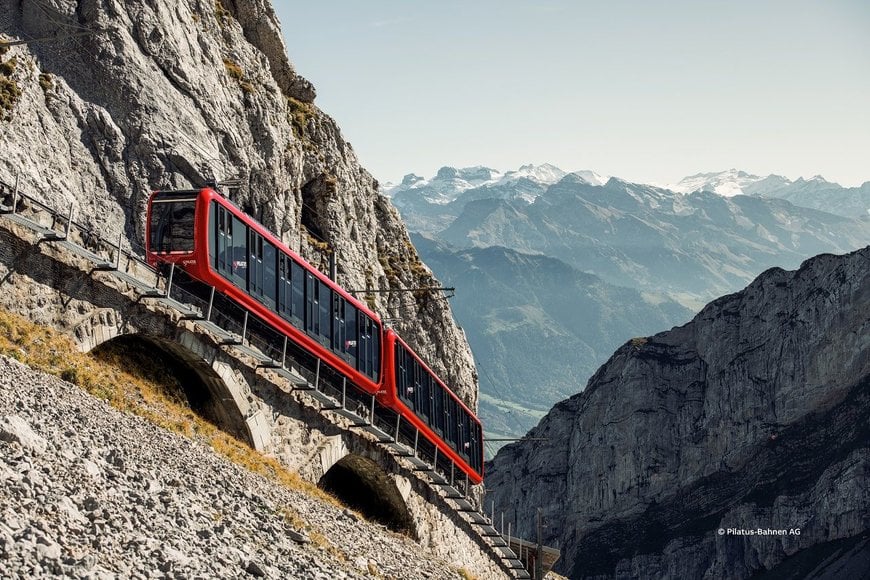www.industryemea.com
16
'23
Written on Modified on
ABB rail technologies meeting the steepest of challenges on Pilatus Bahn
ABB traction converters are powering new rack and pinion trains up the world's steepest cogwheel railway.

Pilatus Bahnen, operator of the world's steepest cogwheel railway with a gradiant of up to 48 percent, has put a new, more energy-efficiency fleet of eight railcars and one freight car into operation at the popular Swiss excursion mountain. Built by leading train manufacturer, Stadler the new fleet is equipped with energy-efficient ABB drive technology that contributes to more efficient, reliable and sustainable rail operations.
"We are pleased to commission this new generation of rack-and-pinion trains equipped with ABB traction inverters featuring the latest drive technology," comments Godi Koch, CEO, Pilatus-Bahnen AG. "These enable more energy-efficient operation and enhance the comfort and speed of the ride for our guests."
Gil Fischer, Local Division Manager ABB Traction Switzerland, adds, "we are very pleased that ABB drive solutions are also being used in the latest generation of vehicles and that we are supporting Pilatus-Bahnen AG on its way to continued reliable and even more efficient rail operations."
The planning, construction and testing phases were undertaken in close collaboration between ABB and Stadler over a multiple year period due to the challenging nature of the project. Design of the new trains called for large glass fronts and a panoramic glass roof to enhance the viewing experience of visitors to Mount Pilatus. In addition, a narrow gauge and horizontal train gear with the perforated principle limit the available space for electrical components. ABB was therefore tasked with developing a new, powerful but compact, lightweight and robust solution that would be mounted underneath the wagons.
Thanks to ABB's energy-efficient traction converters, the new rack-and-pinion railcars also consume 30 percent less energy than the previous generation of trains. During braking, the electrical energy generated is fed back into the grid and available to use for the ascent. This works in the way that motors serve as generators that convert the kinetic energy into electricity, which flows back into the overhead line via traction converters, instead of converting the braking energy into waste heat.
The descent is guaranteed even in the event of an interruption in the overhead line thanks to the conversion of braking energy into electrical energy for the emergency power supply on the vehicle.
The custom-designed ABB traction converter solution is compactly housed in a single enclosure. Two traction converters are installed underneath each train unit. They convert the electrical energy from the overhead line into the voltage and frequency required to drive the traction motors.
Pilatus is a popular destination for thousands of Swiss and international guests. The 4.6 kilometer route between Alpnachstad and the terminus Pilatus Kulm reaches an elevation of 2073 meters and offers expansive views across Central Switzerland. The rack railway covers almost 1,700 meters in altitude gain with an average gradient of 35 percent and a maximum gradient of 48 percent.
ABB supplies a wide range of innovative and custom-designed drive solutions to meet the myriad requirements posed by various rail vehicle concepts. ABB technologies tailored to customer needs are also in reliable use in the meter-gauge and cogwheel railways of Appenzeller Bahnen, Berner Oberland Bahn, Matterhorn Gotthard Bahn, Rhätische Bahnen and Zentralbahn.
"We are pleased to commission this new generation of rack-and-pinion trains equipped with ABB traction inverters featuring the latest drive technology," comments Godi Koch, CEO, Pilatus-Bahnen AG. "These enable more energy-efficient operation and enhance the comfort and speed of the ride for our guests."
Gil Fischer, Local Division Manager ABB Traction Switzerland, adds, "we are very pleased that ABB drive solutions are also being used in the latest generation of vehicles and that we are supporting Pilatus-Bahnen AG on its way to continued reliable and even more efficient rail operations."
The planning, construction and testing phases were undertaken in close collaboration between ABB and Stadler over a multiple year period due to the challenging nature of the project. Design of the new trains called for large glass fronts and a panoramic glass roof to enhance the viewing experience of visitors to Mount Pilatus. In addition, a narrow gauge and horizontal train gear with the perforated principle limit the available space for electrical components. ABB was therefore tasked with developing a new, powerful but compact, lightweight and robust solution that would be mounted underneath the wagons.
Thanks to ABB's energy-efficient traction converters, the new rack-and-pinion railcars also consume 30 percent less energy than the previous generation of trains. During braking, the electrical energy generated is fed back into the grid and available to use for the ascent. This works in the way that motors serve as generators that convert the kinetic energy into electricity, which flows back into the overhead line via traction converters, instead of converting the braking energy into waste heat.
The descent is guaranteed even in the event of an interruption in the overhead line thanks to the conversion of braking energy into electrical energy for the emergency power supply on the vehicle.
The custom-designed ABB traction converter solution is compactly housed in a single enclosure. Two traction converters are installed underneath each train unit. They convert the electrical energy from the overhead line into the voltage and frequency required to drive the traction motors.
Pilatus is a popular destination for thousands of Swiss and international guests. The 4.6 kilometer route between Alpnachstad and the terminus Pilatus Kulm reaches an elevation of 2073 meters and offers expansive views across Central Switzerland. The rack railway covers almost 1,700 meters in altitude gain with an average gradient of 35 percent and a maximum gradient of 48 percent.
ABB supplies a wide range of innovative and custom-designed drive solutions to meet the myriad requirements posed by various rail vehicle concepts. ABB technologies tailored to customer needs are also in reliable use in the meter-gauge and cogwheel railways of Appenzeller Bahnen, Berner Oberland Bahn, Matterhorn Gotthard Bahn, Rhätische Bahnen and Zentralbahn.
www.abb.com.

